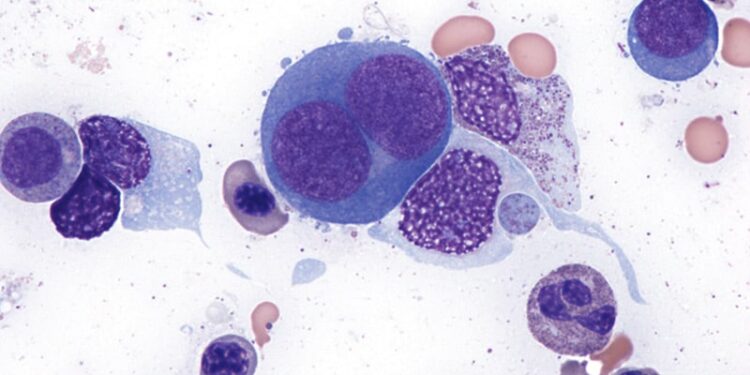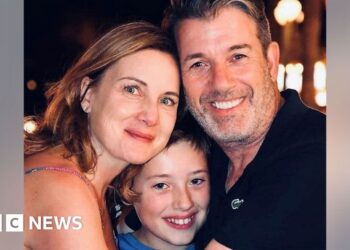TOPLINE:
Erythroid-predominant myelodysplastic neoplasms (EP MDS) (18%) exhibit unique genomic features with frequent TP53 mutations and distinct survival patterns. These cases show poor outcomes with venetoclax therapy due to BCL-XL dependence rather than BCL2, suggesting the need for alternative treatment strategies.
METHODOLOGY:
- Researchers evaluated 371 consecutive patients with newly diagnosed MDS presenting between December 2016 and January 2023, excluding those with chronic myelomonocytic leukemia and acute erythroid leukemia.
- A separate cohort of 112 consecutive patients with higher-risk MDS and increased blasts > 5% received hypomethylating agent plus venetoclax therapy between April 2017 and November 2023.
- Patients with insufficient, poor, or inadequate bone marrow samples were excluded to avoid hemodilution confounding effects.
- EP MDS were defined as those with > 50% normoblasts plus pronormoblasts as a percentage of total bone marrow nucleated cells, while multi-hit TP53-mutated status was defined as having 2 distinct TP53 mutations, concomitant TP53 mutation and deletion of chromosome 17p/TP53, or TP53 variant allele frequency of > 50%.
TAKEAWAY:
- EP MDS (n = 67; 18%) showed higher frequencies of TP53 mutations (multi-hit TP53: 36% vs 17%; P = .004), BCOR mutations (12% vs 4%; P = .015), and WT1 mutations (9% vs 2%; P = .011) than non-EP cases (n = 304; 82%).
- Three distinct genetic subgroups were identified in EP cases with significantly different survival outcomes: TP53 mutant (median survival, 11.4 months), splicing mutant (not reached), and not otherwise specifiable (19.5 months) (P < .001).
- Among hypomethylating agent-venetoclax treated patients, EP cases showed higher leukemic transformation rates (32% vs 12%; P = .040) and worse survival (8.3 months vs not reached; P = .041).
- Immunohistochemistry analysis revealed significantly higher BCL-XL-positive cell frequencies in EP than in non-EP cases (62.5% vs 10%; P = .013), with lower BCL2-positive cell frequencies (5% vs 30%; P = .052).
IN PRACTICE:
“Overall, our findings provide a detailed characterization of EP MDS and demonstrate its distinct molecular and clinical profile compared to NEP MDS. Notably, we demonstrate that although EP MDS comprises distinct genomic subsets with diverging clinical behavior, a group of these patients experience poor outcomes with currently available therapies. Our work supports the development of alternative therapeutic strategies in high-risk EP MDS cases. It sets the basis for recognizing the importance of dynamically assessing erythroid populations in MDS and developing future clinical trials evaluating the activity of BCL-XL inhibitors in this group of patients,” the authors of the study wrote.
SOURCE:
This study was led by Alexandre Bazinet, MD, Sanam Loghavi, MD, and Guillermo Montalban-Bravo, MD, at The University of Texas MD Anderson Cancer Center in Houston. It was published online in Leukemia.
LIMITATIONS:
The researchers acknowledged several limitations, including that results were from a single-center study. The low frequency of EP MDS (18% of all cases) limited their ability to definitively identify distinct genomic subgroups. Limited sample availability affected transcriptional characterization and immunohistochemical profiling of large numbers of patients within each EP group. The authors noted that increased BCL-XL expression findings require future validation, and functional studies are needed to confirm whether increased BCL-XL RNA and protein expression translates into BCL-XL dependence. Given the high incidence of TP53 mutations in EP MDS, further studies are needed to determine if poor outcomes with venetoclax-based therapy are driven by TP53 mutations or erythroid-differentiation bias.
DISCLOSURES:
This study was supported by the University of Texas MD Anderson Cancer Center Support Grant CA016672, the University of Texas MD Anderson Myelodysplastic Syndromes/Acute Myeloid Leukemia Moon Shot, and the Translational Molecular Pathology-Immunoprofiling lab MoonShots Platform. Sanam Loghavi, MD, disclosed ties with Amgen, Astellas, and multiple other pharmaceutical companies. Hagop Kantarjian, MD, reported relationships with various pharmaceutical companies including AbbVie, Agios, and Amgen. Guillermo Garcia-Manero, MD, disclosed ties with Celgene Corporation, Astex, and Amphivena. Additional disclosures are noted in the original article.
This article was created using several editorial tools, including AI, as part of the process. Human editors reviewed this content before publication.
Source link : https://www.medscape.com/viewarticle/blood-cell-patterns-predict-poor-venetoclax-response-2025a1000l73?src=rss
Author :
Publish date : 2025-08-11 05:40:00
Copyright for syndicated content belongs to the linked Source.













